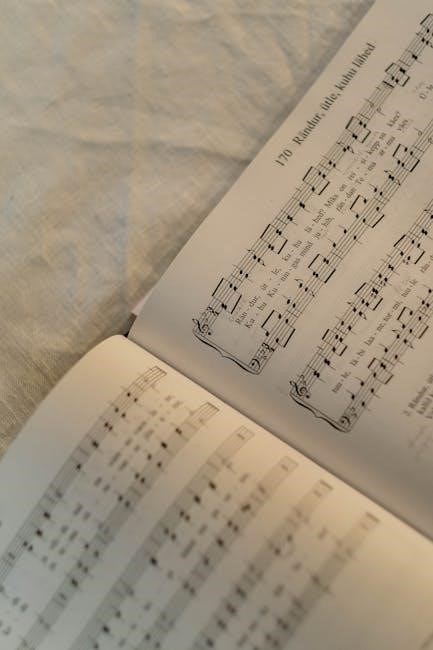
song of solomon toni morrison pdf
Song of Solomon by Toni Morrison: A Comprehensive Guide (PDF Focus)
Finding a reliable PDF of Toni Morrison’s Song of Solomon can aid study. YouTube Music offers over 100 million songs, alongside albums and playlists. Explore the Nobel laureate’s legacy through digital access, enhancing literary exploration and critical analysis;
II. Understanding the PDF Format & Availability
PDFs (Portable Document Format) offer a convenient way to access Song of Solomon, preserving formatting across devices. However, availability varies significantly. Legitimate sources include university libraries offering digital access to students, and online bookstores selling authorized digital editions. These often require purchase or institutional login.
Free PDFs are frequently encountered online, but their legality and quality are questionable (discussed further in Section IV). These may contain errors, incomplete text, or even malware. YouTube Music, while primarily a music streaming service, highlights the accessibility of digital content, mirroring the desire for convenient access to literature.
Authorized PDFs typically include features like searchable text, adjustable font sizes, and the ability to take notes. They often replicate the pagination of the original print edition. Consider formats compatible with e-readers and tablets for optimal reading. Exploring platforms like Google Books can sometimes reveal preview options or links to purchase legitimate PDFs. Remember, supporting authors and publishers through legal purchases ensures continued literary creation.
The increasing prevalence of digital platforms, like YouTube Music with its vast library, demonstrates a shift towards readily available content. However, this convenience must be balanced with respect for copyright and the pursuit of reliable sources when studying a complex work like Song of Solomon.

IV. Risks of Downloading Illegal PDFs
Downloading unauthorized PDFs of Song of Solomon carries significant risks. Beyond the ethical and legal implications of copyright infringement, these files often harbor malicious software. Viruses, malware, and spyware can compromise your device and personal data, leading to identity theft or financial loss.
Illegitimate sources frequently distribute PDFs containing errors, incomplete chapters, or poor formatting, hindering comprehension and academic study. These versions may lack crucial footnotes or critical apparatus essential for a thorough understanding of Morrison’s work. The convenience of a “free” download is often outweighed by the compromised quality.
Furthermore, websites offering illegal PDFs often engage in deceptive practices, such as redirecting users to phishing sites or bombarding them with unwanted advertisements. These sites may also collect your browsing data without your consent. YouTube Music, as a legitimate platform, prioritizes user security and offers a safe streaming experience, contrasting sharply with the dangers of illicit downloads.
Protecting yourself requires vigilance. Always obtain digital copies from reputable sources – authorized bookstores, university libraries, or established academic databases. Prioritize legal access to ensure a secure and reliable reading experience, respecting both the author’s rights and your own digital safety.
V. Historical and Cultural Context
Toni Morrison’s Song of Solomon, published in 1977, is deeply rooted in the historical and cultural landscape of post-Civil Rights America. The novel reflects the burgeoning Black Arts Movement and the ongoing struggle for racial equality, exploring themes of identity, heritage, and the search for belonging within a society still grappling with the legacy of slavery.
The 1960s, a period of immense social upheaval, profoundly shaped Morrison’s literary vision. The Civil Rights Movement challenged segregation and discrimination, while the Black Power Movement emphasized self-determination and cultural pride. These influences are palpable in the novel’s exploration of Black history, folklore, and the complexities of African American life.
Morrison masterfully weaves elements of African mythology and oral tradition into the narrative, grounding the story in a rich cultural heritage. The significance of names, ancestry, and storytelling are central to the characters’ journeys of self-discovery. Like discovering new music on platforms like YouTube Music, understanding the context enriches the experience.
The novel’s setting, primarily in the mid-20th century, provides a backdrop of economic hardship, social injustice, and the psychological impact of racism. Exploring this context is crucial for appreciating the novel’s nuanced portrayal of Black identity and the enduring power of community and resilience.
VI. The African American Experience in the 1960s
Song of Solomon vividly portrays the African American experience during the tumultuous 1960s, a decade marked by both progress and persistent struggle. The novel captures the shifting dynamics of racial identity, the rise of Black consciousness, and the enduring impact of systemic racism on individuals and communities.
The Civil Rights Movement, striving for legal equality, is a subtle undercurrent, while the more assertive Black Power Movement, advocating for self-determination, resonates in characters’ desires for agency and control over their own narratives. Morrison doesn’t depict direct protest, but rather the internal battles fought within individuals navigating a racially charged society.
Economic disparities and limited opportunities are starkly illustrated, impacting characters’ aspirations and choices. The search for economic stability and social mobility becomes intertwined with the quest for self-discovery, mirroring the broader challenges faced by African Americans during this era. Like exploring diverse genres on YouTube Music, the novel showcases a multifaceted experience.
Furthermore, the novel explores the psychological toll of racism, including internalized oppression and the struggle to maintain a sense of self-worth in the face of discrimination. Morrison’s characters grapple with questions of identity, belonging, and the legacy of slavery, reflecting the complex realities of African American life in the 1960s.
VII. Morrison’s Literary Influences

Toni Morrison’s distinctive literary style wasn’t formed in isolation; it’s a rich tapestry woven from diverse influences. Like discovering new artists on YouTube Music, Morrison drew inspiration from a wide range of sources, blending them into a uniquely powerful voice. African American folklore and oral traditions are paramount, shaping her narrative structure and character development.
The blues, jazz, and spirituals permeate her work, providing both thematic resonance and stylistic inspiration. The improvisational quality of jazz, with its emphasis on rhythm and call-and-response, mirrors Morrison’s lyrical prose and complex dialogue. She aimed to capture the cadence and emotional depth of Black vernacular speech.
Furthermore, Morrison was deeply influenced by modernist writers like William Faulkner and Virginia Woolf, admiring their experimental techniques and psychological depth. She adopted and adapted these techniques, infusing them with a distinctly African American perspective. Faulkner’s exploration of Southern history and Woolf’s stream-of-consciousness style are evident in her novels.
Additionally, the works of James Baldwin and Richard Wright, pioneers of African American literature, provided a crucial foundation. Morrison built upon their legacy, pushing the boundaries of representation and challenging conventional literary norms. Her work, like a curated playlist, reflects a careful selection and arrangement of artistic influences.
VIII. Plot Summary & Key Events
Song of Solomon chronicles the life of Macon “Milkman” Dead III, born into a middle-class Black family in 1930s Michigan. The novel, much like exploring a vast music library on YouTube Music, unfolds through a series of interconnected events and revelations. Milkman’s early life is marked by a sense of alienation and a search for identity, fueled by his father’s pragmatic materialism and his mother’s lingering grief.
A pivotal event is Milkman’s discovery of his family’s history, spurred by his aunt Pilate’s unconventional wisdom and a mysterious inheritance. This sets him on a journey south, tracing his ancestry to the rural landscapes of Virginia. He learns of his grandfather’s stolen land and the legacy of slavery that continues to haunt his family.
Throughout his travels, Milkman encounters a diverse cast of characters, each contributing to his growing understanding of himself and his heritage. He forms complex relationships, experiences love and loss, and confronts the harsh realities of racial prejudice. The search for gold becomes intertwined with a deeper quest for self-discovery.
Ultimately, Milkman’s journey culminates in a profound realization of his connection to his ancestors and the importance of community. He learns to fly, not literally, but metaphorically, embracing his identity and breaking free from the constraints of his past. The novel’s ending offers a sense of hope and transcendence, echoing the power of music to uplift and inspire.
IX. Milkman Dead’s Journey of Self-Discovery
Macon “Milkman” Dead’s journey is the heart of Toni Morrison’s Song of Solomon, a quest mirroring the exploration of diverse genres available on YouTube Music. Initially, Milkman is a detached and self-absorbed character, defined by his privileged upbringing and a lack of purpose. He drifts through life, seeking material possessions and superficial connections.
However, the revelation of his family’s past, particularly the story of his grandfather’s stolen land, ignites a desire for something more profound. This sparks a physical and spiritual journey south, a descent into his ancestral roots. He’s driven by the promise of gold, but ultimately seeks a richer inheritance – a sense of belonging and identity.

Along the way, Milkman confronts the complexities of race, class, and history. He witnesses the enduring legacy of slavery and the resilience of the African American community. Encounters with figures like Pilate and Hagar force him to confront his own flaws and biases.
Through these experiences, Milkman gradually sheds his materialistic tendencies and develops a deeper understanding of his heritage. He learns to value relationships, embrace his cultural identity, and recognize the importance of storytelling. His final act of “flying” symbolizes his liberation and self-acceptance, a triumphant culmination of his transformative journey.
X. The Significance of Names and Ancestry
In Song of Solomon, Toni Morrison masterfully weaves names and ancestry into the very fabric of the narrative, echoing the diverse musical catalog available on platforms like YouTube Music. Names aren’t merely identifiers; they carry weight, history, and a connection to the past. Milkman’s nickname, a result of an unusual childhood incident, initially signifies a lack of agency and a stunted emotional development.
The Dead family name itself is ironic, representing a disconnection from their African roots and a loss of cultural memory. Pilate, however, deliberately rejects conventional naming practices, choosing a biblical name that symbolizes strength and spiritual power. Her unconventional life and connection to the land represent a reclaiming of ancestral wisdom.
Morrison meticulously traces Milkman’s lineage, revealing a complex history of slavery, migration, and resilience. The search for his ancestors isn’t simply about uncovering family history; it’s about understanding the collective trauma and triumphs of the African American experience.
The story of Solomon, Milkman’s great-grandfather, embodies the power of flight and the enduring spirit of freedom. Discovering this lineage allows Milkman to connect with a legacy of courage and self-determination, ultimately leading to his own personal liberation and a renewed sense of identity.
IXI. Major Characters Analysis
Toni Morrison’s Song of Solomon presents a rich tapestry of characters, each grappling with identity, belonging, and the weight of history – much like exploring diverse artists on YouTube Music. Milkman Dead, the protagonist, undergoes a transformative journey from self-absorption to self-awareness, driven by a quest for his family’s past.
Pilate Dead, Milkman’s aunt, stands as a powerful spiritual figure, embodying a connection to ancestral traditions and a rejection of societal norms. She offers guidance and a different perspective on life, challenging conventional morality.
Hagar, a tragic figure, represents the devastating consequences of unrequited love and societal expectations. Her obsessive devotion to Milkman highlights the vulnerability and pain experienced by women in a patriarchal society.

Guitar Baines, Milkman’s childhood friend, embodies a more radical response to racial injustice, advocating for violence as a means of retribution. His contrasting worldview forces Milkman to confront difficult questions about justice and morality.
Circe, a complex and enigmatic character, represents the enduring power of storytelling and the preservation of cultural memory. Through her, Morrison emphasizes the importance of oral tradition and the transmission of knowledge across generations.
XII. Milkman Dead: Protagonist & Transformation
Milkman Dead, born Macon Dead III, embodies a complex journey of self-discovery throughout Toni Morrison’s Song of Solomon. Initially, he’s portrayed as a self-absorbed and materialistic young man, disconnected from his heritage and driven by superficial desires – a stark contrast to discovering new artists on platforms like YouTube Music.
His transformation begins with his aunt, Pilate, and the pursuit of gold, which evolves into a quest for his family’s history. This journey takes him south, forcing him to confront the realities of racial injustice and the legacy of slavery. He learns about his grandfather’s stolen land and the sacrifices made by his ancestors.
Throughout his travels, Milkman sheds his materialistic tendencies and develops a deeper understanding of his identity. He learns to value human connection and the importance of community. His relationship with Pilate is pivotal, as she provides him with spiritual guidance and a connection to his roots.
Ultimately, Milkman’s transformation culminates in his acceptance of his heritage and his embrace of his true name, Macon Dead. He achieves a sense of wholeness and purpose, transcending the limitations of his upbringing.
His flight, both literal and metaphorical, symbolizes his liberation and his newfound understanding of himself and his place in the world.
XIII. Pilate Dead: A Spiritual Guide
Pilate Dead stands as a profoundly unconventional yet vital spiritual force within Song of Solomon. Unlike conventional religious figures, Pilate operates outside societal norms, embodying a raw, earthy spirituality deeply connected to the natural world and ancestral wisdom – a connection akin to discovering hidden gems within YouTube Music’s vast library.
She is Milkman’s aunt and a source of unwavering support and guidance. Pilate possesses an intuitive understanding of the world, unburdened by the constraints of formal education or societal expectations. Her unconventional lifestyle, including her lack of a navel, symbolizes her unique connection to life and death.
Pilate’s home serves as a sanctuary, a space where Milkman can begin to unravel the mysteries of his family history and confront his own inner demons. She encourages him to explore his past and to embrace his heritage, offering a counterpoint to the materialistic values of his father.
Her rituals and beliefs, rooted in African traditions, provide Milkman with a spiritual framework for understanding his identity and his place in the world. She represents a connection to a past that has been deliberately obscured by the forces of racism and oppression.
Pilate’s death, though tragic, ultimately serves to liberate Milkman, allowing him to fully embrace his destiny and complete his journey of self-discovery.
XIV. Hagar: Love, Loss, and Obsession
Hagar represents a poignant exploration of love, loss, and the destructive power of obsession within Song of Solomon. Her character embodies the devastating consequences of unrequited affection and the societal pressures placed upon Black women to define themselves through romantic relationships – a theme resonating with the diverse musical narratives found on platforms like YouTube Music.
Hagar’s intense, all-consuming love for Milkman stems from a childhood connection and a desperate need for validation. When Milkman rejects her, she spirals into a profound despair, her identity inextricably linked to his presence. Her attempts to win him back, through increasingly desperate and self-destructive acts, highlight the fragility of self-worth.
Morrison portrays Hagar’s decline with unflinching honesty, depicting her physical and emotional deterioration as a consequence of her broken heart. Her obsession consumes her, leading to isolation and ultimately, her death. Hagar’s story serves as a cautionary tale about the dangers of seeking fulfillment solely through romantic love.
Her relentless pursuit of Milkman, even after repeated rejection, underscores the societal constraints that limit Black women’s options and reinforce the importance of self-reliance. Hagar’s tragedy is not merely a personal one; it is a reflection of the systemic forces that contribute to her downfall.
Ultimately, Hagar’s fate compels readers to confront the complexities of love, loss, and the search for identity in a world marked by racial and gender inequality.
XVI. The Search for Identity and Heritage
Central to Song of Solomon is Milkman Dead’s arduous journey of self-discovery, inextricably linked to uncovering his family’s heritage – a quest mirroring the exploration of diverse musical genres available on platforms like YouTube Music. Initially, Milkman is detached and self-absorbed, lacking a sense of belonging or purpose.
His pursuit of gold, spurred by his father’s stories, gradually transforms into a quest for ancestral knowledge. As he travels south, Milkman begins to piece together the fragmented history of his ancestors, learning about their experiences with slavery, resilience, and cultural traditions.
The discovery of his grandfather’s stolen land and the stories of his great-grandfather, Solomon, are pivotal moments in Milkman’s awakening. He learns that his family’s name is not merely a surname but a legacy of flight and freedom, a testament to the enduring spirit of his ancestors.
This genealogical exploration allows Milkman to connect with a past that has been deliberately obscured, reclaiming a sense of identity that had been denied to him. The oral traditions and storytelling practices of the Black community play a crucial role in this process, preserving and transmitting cultural memory.
Ultimately, Milkman’s journey underscores the importance of understanding one’s roots in order to forge a meaningful and authentic identity. His search for heritage is not simply a personal quest but a collective one, reflecting the broader struggle of African Americans to reclaim their history and define their place in the world.

XVII. The Power of Storytelling and Oral Tradition
Throughout Song of Solomon, Toni Morrison powerfully demonstrates the vital role of storytelling and oral tradition in preserving history, shaping identity, and fostering community – a concept akin to discovering new artists and playlists on platforms like YouTube Music.
In the absence of written records, particularly for enslaved African Americans, oral narratives became the primary means of transmitting cultural knowledge, ancestral memories, and personal experiences across generations. The stories shared within the Black community served as a repository of wisdom, resilience, and resistance.

Characters like Pilate Dead embody the power of oral tradition, possessing a deep connection to the past and a unique ability to interpret and share its lessons. Her unconventional lifestyle and spiritual wisdom are rooted in the stories she has heard and the experiences she has lived.
The novel itself is structured around a series of interwoven narratives, reflecting the cyclical and communal nature of storytelling. Morrison employs a lyrical and evocative prose style that mimics the rhythms and cadences of oral speech, immersing the reader in the world of the story.
The act of naming, for instance, is imbued with significance, as names carry the weight of history and ancestry. Milkman’s journey is, in essence, a quest to uncover the stories behind his family’s names and to understand their meaning. Ultimately, Morrison celebrates the power of storytelling to heal, empower, and connect individuals to their heritage.
XVIII. Flight and Freedom: Literal and Metaphorical
The motif of flight permeates Song of Solomon, functioning on both literal and deeply metaphorical levels, mirroring the expansive musical landscape available through services like YouTube Music, offering a vast array of sounds and experiences.
The legend of the flying Africans, a powerful symbol of resistance and liberation, serves as a foundational element of the novel. These stories, passed down through oral tradition, depict enslaved people who chose to fly back to Africa rather than endure the horrors of slavery. This act of flight represents a rejection of oppression and a yearning for freedom.
Milkman Dead’s own journey can be interpreted as a metaphorical flight, a quest for self-discovery and liberation from the constraints of his family history and societal expectations. His travels south lead him to uncover the truth about his ancestors and to embrace his own identity.
The act of flying also symbolizes a transcendence of earthly limitations and a connection to the spiritual realm. Characters like Pilate possess a mystical quality that suggests a capacity for flight, both literal and figurative.
Morrison explores the complexities of freedom, suggesting that it is not simply a matter of physical liberation but also a state of mind and spirit. True freedom requires an understanding of one’s past, an acceptance of one’s identity, and a willingness to embrace one’s potential. The pursuit of freedom, like discovering new music, is a continuous journey.
XIX. Literary Style and Techniques
Toni Morrison’s literary style in Song of Solomon is richly textured and innovative, employing a range of techniques to create a powerful and immersive reading experience, much like the diverse musical offerings found on platforms like YouTube Music.
Morrison masterfully utilizes lyrical prose, infusing her writing with a poetic quality that evokes the rhythms and cadences of African American oral tradition. Her language is often evocative and symbolic, inviting multiple interpretations.
The novel’s narrative structure is non-linear, shifting between different time periods and perspectives. This fragmented approach mirrors the complexities of memory and the challenges of reconstructing the past.
Morrison frequently employs symbolism and imagery, using objects, colors, and natural elements to convey deeper meanings. The motif of flight, for example, represents both literal escape and spiritual transcendence.
Her character development is nuanced and complex, revealing the inner lives and motivations of her characters through their thoughts, actions, and interactions. She avoids simplistic portrayals, presenting characters with both strengths and flaws.
Furthermore, Morrison’s use of folklore and myth adds another layer of depth to the novel, grounding it in the cultural traditions of the African American community. This blending of realism and myth creates a unique and compelling literary world.

XX. Morrison’s Use of Symbolism and Imagery
Throughout Song of Solomon, Toni Morrison employs a rich tapestry of symbolism and imagery, elevating the narrative beyond a simple recounting of events, much like the diverse musical genres available on YouTube Music cater to varied tastes.
The most prominent symbol is arguably flight, representing freedom, escape from oppression, and a yearning for spiritual transcendence. Milkman’s journey mirrors the mythical flight of enslaved Africans, seeking liberation and self-discovery.
Names themselves hold significant symbolic weight. “Milkman” is a derogatory term, yet he reclaims it, transforming it into a symbol of his evolving identity. Pilate’s unconventional name and lack of a navel symbolize her connection to ancestral roots and spiritual power.
Gold and material wealth represent both opportunity and corruption. The pursuit of gold often leads to greed and exploitation, highlighting the destructive consequences of materialism.
Water imagery frequently appears, symbolizing purification, rebirth, and the fluidity of identity. The river Jordan, for instance, represents a spiritual cleansing and a return to origins.
Morrison’s use of color imagery is also striking. Red often signifies passion, danger, and violence, while blue evokes a sense of melancholy and longing. These symbolic colors contribute to the novel’s emotional depth.
Ultimately, Morrison’s masterful use of symbolism and imagery enriches the narrative, inviting readers to delve deeper into the novel’s complex themes and explore the multifaceted nature of human experience.
XXI. Narrative Structure and Point of View

Toni Morrison’s Song of Solomon employs a complex and deliberately non-linear narrative structure, mirroring the fragmented nature of memory and the search for identity, much like exploring diverse playlists on YouTube Music.
The novel doesn’t follow a strictly chronological order. Instead, Morrison weaves together past and present, gradually revealing the interconnectedness of characters and events. This fragmented approach mirrors Milkman’s own piecemeal discovery of his family history.
The narrative shifts perspectives, though primarily remains anchored in a third-person limited point of view, focusing on Milkman’s consciousness. However, Morrison frequently dips into the perspectives of other characters, particularly Pilate and Hagar, offering a broader understanding of the story’s events.
This shifting perspective allows Morrison to explore the subjective nature of truth and the limitations of individual perception. Each character’s experience shapes their understanding of the world, and the novel invites readers to consider multiple viewpoints.
The use of foreshadowing and recurring motifs creates a sense of inevitability and reinforces the novel’s thematic concerns. Certain images and symbols reappear throughout the narrative, subtly hinting at future developments.
Morrison’s narrative structure isn’t simply a stylistic choice; it’s integral to the novel’s meaning. The fragmented form reflects the fractured history of African Americans and the challenges of constructing a cohesive identity in the face of oppression.
Ultimately, the novel’s narrative complexity demands active engagement from the reader, rewarding careful attention to detail and a willingness to embrace ambiguity.

XXII. Critical Reception and Awards
Upon its 1977 publication, Song of Solomon was met with widespread critical acclaim, solidifying Toni Morrison’s position as a major voice in American literature, much like discovering top talent on YouTube Music.
Reviewers lauded Morrison’s lyrical prose, her complex characters, and her unflinching exploration of race, gender, and identity. Reynolds Price, in a notable review, found within the story “evidence for the possibility of transcendence within human life.”
The novel’s innovative narrative structure and its blending of myth, folklore, and historical realism were also praised. Critics recognized Morrison’s ability to weave together personal and collective experiences, creating a powerful and resonant narrative.
Song of Solomon garnered numerous awards and accolades, including the National Book Critics Circle Award in 1978. This recognition helped to bring Morrison’s work to a wider audience and established her as a leading figure in contemporary literature.
The novel’s enduring popularity has led to its inclusion in numerous university curricula and its continued study by scholars and students alike. It remains a staple of African American literature and a significant contribution to the American literary canon.
Morrison’s subsequent works continued to receive critical acclaim, culminating in her being awarded the Nobel Prize in Literature in 1993. This prestigious award acknowledged her profound impact on the literary landscape.
The lasting critical reception of Song of Solomon demonstrates its enduring power and its continued relevance in contemporary society, prompting ongoing discussion and analysis.
XXIII. Reynolds Price’s Review and Transcendence
Reynolds Price’s 1977 review of Toni Morrison’s Song of Solomon stands as a particularly insightful and influential assessment of the novel’s profound themes, akin to discovering a hidden gem within a vast music library like YouTube Music.
Price, a celebrated author himself, didn’t merely analyze the plot or characters; he delved into the spiritual and philosophical core of the work. He argued that within the sprawling narrative of Milkman Dead’s journey, Morrison presented “evidence for the possibility of transcendence within human life.”
This notion of transcendence – a rising above the limitations of earthly existence – resonated deeply with Price, who saw Morrison’s novel as a testament to the human capacity for growth, self-discovery, and spiritual awakening. He believed the novel offered a glimpse into a realm beyond the material world.
Price highlighted Morrison’s masterful use of language and imagery, noting how she created a world that was both grounded in the realities of African American experience and infused with a sense of the mystical and the magical;
He praised her ability to portray the complexities of human relationships and the enduring power of family and community. Price’s review emphasized the novel’s exploration of themes such as identity, heritage, and the search for meaning.
His interpretation of Song of Solomon as a work that grapples with the possibility of transcendence has become a central tenet in the novel’s critical reception, influencing generations of readers and scholars.
Price’s review remains a powerful testament to the enduring legacy of Morrison’s masterpiece and its ability to inspire and uplift.